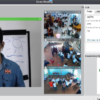What do Harvard University, the United States Department of Defense and a group of monks in Myanmar have in common? A local company and an Ottawa-born software are behind all of their online classrooms.
Blindside Networks develops an open-source software called BigBlueButton that allows students and teachers to gather in one electronic space. The software plugs into learning management systems such as Moodle, as well as nearly every other major online learning provider.
The platform allows for video chats, shared screens, interactive polling, shared note-taking and more.
(Sponsored)

For the fifth year in a row, Ottawa will become the epicentre of Canadian culinary excellence in late January. Chefs from Ottawa, Vancouver, Edmonton, Calgary, Saskatoon, Winnipeg, Toronto, Montreal, Moncton

Desjardins Elevator Pitch Competition drives entrepreneurial energy at uOttawa
In uOttawa’s Desjardins Elevator Pitch Competition, a single team member stands before the judges, pitching for three minutes, fielding questions for five. There are no decks, notes, props or prototypes
More than 100 universities, including Harvard, Columbia and EU Business School, have BigBlueButton integrated into their LMS. It’s currently the sixth-most-used plug-in on the Moodle platform, and more than 5,000 websites in the world currently run the Ottawa-built software.
“We have become the de facto standard for online learning,” says CEO and co-founder Fred Dixon.
But Blindside’s story is about more than a classroom: It’s a validation of open source as a business model, a government IT solution and a way to make technology accessible to users around the world.
Open-source revenues
The BigBlueButton project has its roots in Carleton University’s Technology Information Management program. Roughly a decade ago, director Tony Bailetti harnessed the school’s resources towards unlocking the business model behind open-source technologies.
Mr. Dixon said Mr. Bailetti was looking for an alternative to the expensive online classroom software that existed at the time. It was Richard Alam, a former Nortel engineer, who first began developing the origins of BigBlueButton at Carleton.
At that time, Mr. Dixon was looking for a new project. He had just exited from his previous firm, a web-based data analysis tool launched in 1995. Databeacon, as it was known, raised $13.5 million over three investment rounds, eventually being acquired by Cognos in 2004.
“We have become the de facto standard for online learning,”
Fred Dixon, CEO of Blindside Networks
When Mr. Dixon discovered what Mr. Alam was working on, he says he thought immediately “there’s something here.”
The nature of open source means that Blindside Networks makes no money directly from users downloading and running the software it helps to develop. Instead, the firm makes its money in two ways: hosting the service for the universities that opt to use it, and upselling additional features.
Much of Blindside Networks’ revenues come from its three data centres spread out through Europe, North America and Australia. Blindside sells directly to its university customers to host BigBlueButton on its servers.
The other revenue stream comes from Blindside’s value-adds to users. The firm can help with setting up, installing and maintaining the software, or it can be contracted to add premium offerings such as permanent access to recordings or other custom features by request.
Blindside Networks now employs 14 full-time staff operating out of an office on Gloucester Street, and it’s looking to grow that number as it continues to scale.
A good defense
Mr. Dixon says his approach to growing the firm has been based on entrepreneuring fundamentals: focus on one market and dominate it. Blindside targeted the education and e-learning sector, but its solution has found enterprise applications as a tool for collaboration.
That’s how the small Ottawa company ended up with the United States Department of Defense as a customer.
In 2014, the DoD found itself frustrated by the proprietary solution it was using for web conferencing. Mr. Dixon says its existing solution was costing the department $14 million a year, and it was in the market for a change.
That’s when someone at the DoD installed BigBlueButton on a laptop and brought it in to show the rest of the team what was possible with an open-source solution. The capabilities of the software aside, its open-source nature let the department view the entire source code, allowing for diagnostics not possible with the incumbent proprietary software.
Mr. Dixon says he was surprised when, a couple years ago, he received an email from a .gov account.
“I had this conference call with them, and they were telling me all of the things they were building out around BigBlueButton. I just about fell out of my chair.”
“When people ask who our customers are, I just say, ‘The U.S. Department of Defense.’ End of conversation.”
Fred Dixon, CEO of Blindside Technologies
Today, the U.S. Department of Defense runs the largest deployment of BigBlueButton in the world, with thousands of users on the system at a time.
“They save $12 million a year on open source software that originated at Carleton University,” Mr. Dixon says.
The DoD invests in Blindside Networks to have the team develop specific functionalities, which in turn contributes to the larger open-source product. There is only one version of BigBlueButton running at any time, Mr. Dixon says, and it’s the result of more than eight years of development and client input.
Ever since the DoD adopted Blindside’s solution, Mr. Dixon says the company hasn’t had much trouble pitching to new clients.
“When people ask who our customers are, I just say, ‘The U.S. Department of Defense.’ End of conversation.”
From Ottawa to Myanmar
Revenue streams aside, Mr. Dixon says one of the major goals of BigBlueButton has been to make education accessible to a wider audience.
The provincial government recently awarded a $200,000 grant through its Ontario Centres of Excellence program to students at Seneca College to make BigBlueButton more accessible to users with disabilities.
Other developers have contributed language features to the open-source platform, allowing for real-time closed captioning.
One of Mr. Dixon’s proudest use cases has been a group of Monastic educators in Myanmar who have adopted BigBlueButton to help reach students in the troubled region. The country’s geographic diversity sometimes makes connecting students and teachers in rural regions difficult, but through Moodle and BigBlueButton, students are able to connect with teachers outside of school.

The BigBlueButton project even developed a low-bandwidth solution to accommodate technical limitations in Myanmar to make sure even the most remote students could watch lecture feeds.
“They don’t pay us anything. But they’re using our product to further the education of students who wouldn’t otherwise have access to it,” Mr. Dixon says.
To be able to run a financially viable company that contributes a social good is at the heart of entrepreneurship for him.
“We’re enabling education around the world. At the end of the day, that makes me feel very good.”



